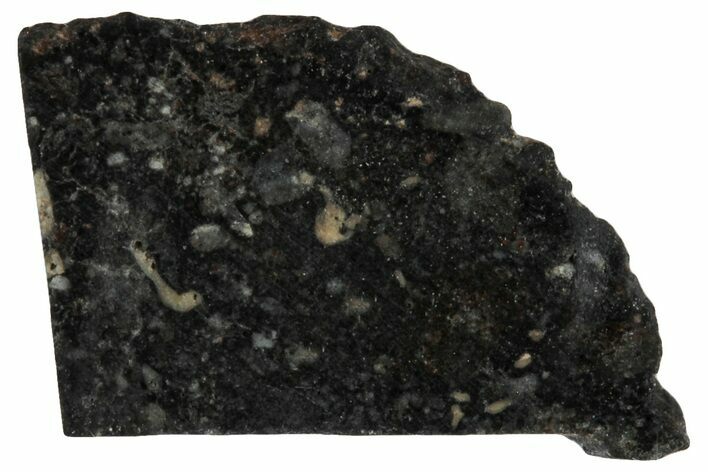This Specimen has been sold.
.57" Polished Lunar Meteorite Slice (.72 g) - NWA 13390
This is a .57" wide (.72 gram) slice of the lunar meteorite NWA 13390. It has been cut into a thin slice and polished to a glossy finish on one side.
Comes in an acrylic display case.
Comes in an acrylic display case.
The NWA 13390 lunar meteorite was discovered in Mauritania in 2017, and was later purchased on April 13th, 2017 by Dustin Dickens from a nomad in Mauritania. It's classified as a lunar fragmental breccia. Only one single NWA 13390 meteorite was recovered and it was devoid of fusion crust. Cut surfaces reveal a fragmental breccia set in a dark-grey ground mass. The total known mass of the NWA 13390 meteorite is 113 kg.
Meteoritical Bulletin: Entry for The NWA 13390 Lunar Meteorite
Meteoritical Bulletin: Entry for The NWA 13390 Lunar Meteorite
Moon Rocks... On Earth...
Think the only moon rocks on Earth are samples brought back from Apollo missions? Think again!
Lunar meteorites are type of achondrite meteorites that were formed like other stony (chondrite) meteorites, but they were ejected into space by meteorites and other celestial bodies hitting the moon. Almost all lunar meteorites are brecciated amalgamations of feldspathic and basaltic rocks commonly found on the Moon's surface.
Lunar meteorites are pretty rare to find on Earth: the vast majority of meteorites are from the asteroid belt, and less than 1 percent of classified meteorites are lunar in origin. The total mass of all known lunar meteorites is probably less than 1,000 kilograms. Owning a piece of the moon is a pretty rare accomplishment!
One reason they are so rare is because lunar meteorites superficially look just like earth rocks. Even a true meteorite expert would not recognize a lunar meteor laying on the ground among earthly stones. Lunar meteorites have only been recognized in places naturally devoid of rocks, like sandy deserts and ice sheets. In fact, there has never been a lunar meteorite classified from North America, South America or Europe. Most are found in the Sahara Desert (Northwest Africa), Antarctica, or Oman. All Antarctic meteorites are governmental property so they cannot be privately attained.
Think the only moon rocks on Earth are samples brought back from Apollo missions? Think again!
Lunar meteorites are type of achondrite meteorites that were formed like other stony (chondrite) meteorites, but they were ejected into space by meteorites and other celestial bodies hitting the moon. Almost all lunar meteorites are brecciated amalgamations of feldspathic and basaltic rocks commonly found on the Moon's surface.
Lunar meteorites are pretty rare to find on Earth: the vast majority of meteorites are from the asteroid belt, and less than 1 percent of classified meteorites are lunar in origin. The total mass of all known lunar meteorites is probably less than 1,000 kilograms. Owning a piece of the moon is a pretty rare accomplishment!
One reason they are so rare is because lunar meteorites superficially look just like earth rocks. Even a true meteorite expert would not recognize a lunar meteor laying on the ground among earthly stones. Lunar meteorites have only been recognized in places naturally devoid of rocks, like sandy deserts and ice sheets. In fact, there has never been a lunar meteorite classified from North America, South America or Europe. Most are found in the Sahara Desert (Northwest Africa), Antarctica, or Oman. All Antarctic meteorites are governmental property so they cannot be privately attained.
TYPE
Lunar (Fragmental Breccia)
AGE
LOCATION
Mauritania
SIZE
.57 x .39 x .10", Weight: .72 gram
CATEGORY
ITEM
#291445
 Reviews
Reviews












